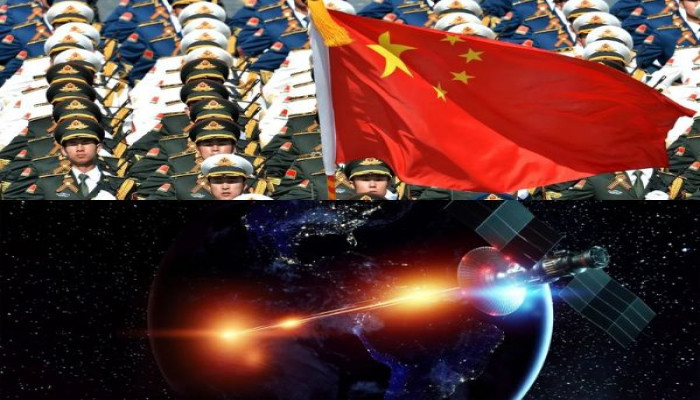China’s expanding space program raises US concerns over growing military capabilities
- In Reports
- 06:03 PM, Jul 15, 2025
- Myind Staff
China’s space program remains a matter of national pride, and its top leader Chairman Xi Jinping wants to overtake the USA as the world’s leading space power. With this as a goal is China is spending heavily on scientific, civilian and military space systems.
So, what kind of progress is China making? In a revised space threat report released in April, the US Space Force described the developments in China and Russia as "a serious threat to US national security interests in, from and to space". The report also warned, "China is the pacing challenge and is rapidly enhancing its space capabilities to track and target US military forces." It noted that China and Russia are developing many types of counter-space systems to disrupt and weaken US space assets.
The data shows China’s fast rise. In the past year, China carried out 68 space missions. These launches placed 260 payloads into orbit. Out of these, 67 were satellites built for intelligence, surveillance and reconnaissance, making up 26 per cent of the total.
In the last decade, China’s number of satellites in space has jumped by 620 per cent. Today, it has more than 1,060 satellites in orbit, which is 875 more than it had in 2015. Of these, over 510 can do ISR missions for the People’s Liberation Army using optical, multispectral, radar and radiofrequency sensors.
This large satellite fleet can scan Earth to locate American aircraft carriers, air squadrons or other military assets.
One major ISR satellite is TJS-12, launched into geosynchronous orbit in December 2024. The US Space Force stated, "The satellite could enable China to continuously monitor US and allied forces in the Pacific region."
Dr Andrew Erickson, a Strategy Professor at the US Naval War College, said, "Of concern of a fundamental nature is the sheer magnitude of satellites China now has in space, and especially ISR, in its systematically constructing a complete, effective reconnaissance-strike complex."
To compete with Starlink, China is also working on a large G60 communications satellite network in low Earth orbit. By early 2025, 72 satellites were already in orbit, and the plan is to reach 648 by the end of the year. China wants to expand this network to about 14,000 satellites by 2030. In 2024, the China Satellite Network Group launched ten more satellites, which mark the beginning of another planned set of 13,000 satellites. After watching Ukraine’s use of Starlink during its conflict with Russia, China has become cautious about such networks and their ties to the US government.
China fears, maybe more than needed, that these systems could send data and create new kinds of warfare for the US.
China’s space systems also play a role in guiding weapons. The US military said, "China's increasing space-based capabilities are combined with the PLA's expanding inventory of long-range precision weapons to support long-range precision strikes against US and allied military forces."
In 2015, China called space "a new domain of warfare". That year, it placed space operations under a newly created PLA Strategic Support Force. But this force was disbanded on 19 April 2024. It was replaced by the PLA Aerospace Force, which now handles military use of space, such as image collection, intelligence gathering, targeting accuracy, communication support and blocking enemy access to space.
This Aerospace Force reports directly to the Central Military Commission, China’s top military authority.
John Costello, writing for The Jamestown Foundation, noted that the Aerospace Force does not follow the PLA’s usual regional command system. He said this shows the force has a special strategic and operational purpose.
The PLA Aerospace Force operates seven main space bases, along with other centres and departments that support its tasks.
The seven bases reflect the types of operations involved. Base 23 is the China Satellite Maritime Tracking and Control Department in Jiangsu Province. Base 25 is the Taiyuan Satellite Launch Centre in the Shanxi mountains. Base 26 is the Xi’an Satellite Control Centre in Shaanxi Province. Base 27 is the Xichang Satellite Launch Centre in Sichuan. Base 35 is a new Battlefield Environment Support Base in Wuhan. Base 36 is the Kaifeng Base in Henan Province, which focuses on space research, testing and evaluation, as Costello wrote.
Base 37 is located in Lintong, Shaanxi Province, and handles early warning work. This includes watching for space activity, tracking missiles and monitoring space debris and satellites. It runs large phased-array radar sites across China to detect foreign missile launches and give a full view of space.
Costello wrote, "The creation of the PLA Aerospace Force is not simply an administrative reform. It is a strategic pronouncement regarding the PRC's perceptions of the place of space in contemporary military competition. Space is often described in Chinese military writing as the 'commanding heights' of future war, and the establishment of the Aerospace Force signals the PLA's determination to take possession of that high ground."
He pointed out a few key findings. First, he said space is central to the PLA’s strategy. "By consolidating all military space capabilities into a single service, the PLA wants to ensure space assets can be centrally directed and quickly deployed in a war. Just as with the concurrent Cyberspace Force and Information Support Force, the Aerospace Force is a barometer of wars Beijing is gearing up for."
If China attacks Taiwan, this force would be involved from the beginning. The PLA would try to secure space for itself and deny others from using it.
Costello said, "This is an expression of their doctrine that the US military makes extensive use of space capabilities, neatly encapsulated in the phrase 'no satellite, no fight'." But this reliance goes both ways, as China’s dependence on space could also become a risk.
He added, "In early stages of a conflict, the Aerospace Force would place navigation satellites to guide precise missile attacks, utilise ISR satellites to acquire targets, and employ anti-satellite (ASAT) assets to disrupt or destroy adversary command, control, communication, computer, intelligence, surveillance and reconnaissance capabilities."
The second point Costello raised is that the Aerospace Force "offers centralised space intelligence and attack capabilities, unfettered by inter-service rivalries. Its technical reconnaissance satellites and the centres processing their data are integrated, theoretically allowing more rapid targeting cycles and a better situational picture for decision-makers."
His third point was that the Aerospace Force "prioritises space control and counter-space". Among its duties are space combat, and China’s space activity is becoming more assertive. Costello said, "With the Aerospace Force in command, such activities (e.g., intensely tailing foreign satellites and testing co-orbital inspector satellites that also can function as weapons) might more intensify under a distinct military chain of command."
This counter-space topic is important. Though China claims peaceful goals in space, it is clearly preparing ways to keep others out. The US Space Force said, "Intelligence indicates the PLA likely believes counter-space operations can be a way of deterring and countering US military involvement in an offshore conflict. Additionally, PLA scholars emphasise the importance of 'destroying, damaging and interfering with the enemy's reconnaissance and communications satellites' to 'blind and deafen the enemy'."
China has already shown its ASAT ability. In 2007, it destroyed a broken weather satellite in low Earth orbit, which created space debris that will stay for decades. The Pentagon said, "That missile became an operational ground-based system designed to attack LEO satellites. The PLA actively operates on this system today."
China also plans to develop ASAT weapons with even longer range, able to strike satellites in geosynchronous orbit 36,000 km away. In 2013, it launched a missile that reached 30,000 km, showing that such a capability may already exist. Few satellites would be beyond its reach.
Besides this, China is building and testing systems that can inspect or move satellites, but could also serve as weapons. In January 2022, the Shijian-21 satellite shifted a damaged BeiDou satellite into a graveyard orbit. The US observed, "This technology could be used in future systems to grapple other satellites." Some of China’s satellite moves have been described by US officials as "dogfighting" in space.
These flexible satellites can move close to enemy satellites and interfere with or harm them. Several SJ and TJS satellites have made unusual and fast movements. One TJS-2 satellite was tracked moving at 44 metres per second. China may also be exploring ways to refuel satellites in space.
The Centre for Strategic and International Studies (CSIS) in the US stated, "China continues to send and operate very manoeuvrable satellites, displaying a high order of technological and operational sophistication that, if not already employed for such ends, may allow for a powerful on-orbit counter-space capability. By employing these satellites, Chinese operators are building experience in creating tactics and procedures that can be applied to space warfighting, including both defensive and offensive advanced space operations."
Erickson added, "While America and the allies do possess capable countermeasures of their own, it is no longer credible to suggest Beijing might lack critical architecture for targeting its long-range precision strike systems, including the world's most dense conventionally armed ballistic and cruise missiles."
China also has laser weapons on the ground that can aim at satellite sensors. The US Space Force warned, "By the mid- to late 2020s, they could have higher-power systems able to damage satellite structures."
In many military drills, China uses jamming systems to block satellite communication, radar and navigation tools like GPS. The US said in its April report, "Intelligence suggests the PLA may be developing jammers to target satellite communications over a range of frequencies, including US military protected extremely high-frequency systems."
Costello also stressed that the Aerospace Force is helping lead space technology progress. "The Aerospace Force can lead in innovative technologies critical to the future of warfare. Whether deploying global-surveillance satellite constellations, creating directed-energy weapons to attack satellites, or fielding rapid-launch 'responsive space' technologies, the Aerospace Force gives a dedicated command to pursue these efforts."
Laser-based ASAT systems are one example.
Another is China’s work on reusable spaceplanes. So far, it has done three launches. The first lasted two days in space, and the second and third lasted about nine months each. The US reported that they released "unidentified objects". At the same time, China "has made significant strides in developing reusable space launch vehicles."
This includes a successful vertical take-off and landing rocket test that reached 12 km last year. These reusable launch systems are important for China’s large low Earth orbit satellite plans.
Even though China does not have a wide global network of ground sensors like the US, which works with allies to host such stations, China now operates at least ten space-based satellites that help track objects and understand what is happening in space.







Comments